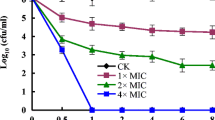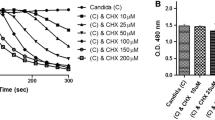Abstract
Histatins, a group of histidine-rich proteins in human saliva, exhibit antimicrobial activity and are therefore considered to be important in the prevention of infections in the oral cavity. Although killing of C. albicans by histatins has been extensively studied, little is known about the processes responsible for this antifungal activity. Recent studies show the requirement of metabolic activity and ATP production for histatin 5 killing activity. Therefore, the goal of this study was to investigate the kinetics of histatin 5 interaction at different temperatures with C. albicanswild type cells and with respiratory deficient mutants of C. albicans. Synthetic histatin 5 was labeled with fluorescein-5-isothiocyanate (FITC) and its association with C. albicans cells was followed by epi-fluorescence microscopy and fluorescence confocal microscopy. At 37 °C, histatin 5 accumulates intracellularly, and both killing activity and uptake of unlabeled and FITC-labeled histatin 5 are time- and concentration-dependent. At 4 °C, no killing is observed and FITC-histatin 5 is only associated with the cytoplasmic membrane. Internalization and killing activity only occurs after cells are transferred to 37 °C. In addition, cellular accumulation of histatin 5 is concomitant with a moderate alteration of membrane integrity leading to the release of UV-absorbing cell components into the medium. The uptake of histatin 5, the release of UV-absorbing materials and killing of C. albicans are markedly decreased by the respiratory inhibitor sodium azide. Concomitantly, respiratory deficient mutants of C. albicans are also less susceptible to histatin 5. These results indicated that histatin 5 killing activity could be directly correlated to histatin 5 internalization. Both of these processes are prevented by modulators of cellular metabolic activity.
Similar content being viewed by others
References
Aoki S & Ito-Kuwa S (1987) Induction of petite mutation with acriflavine and elevated temperature in Candida albicans. J.Med. Veter. Mycol. 25: 269-277
Baum BJ, Bird JL & Longton RW (1977a) Histidine-rich-polypeptides in macaque parotid saliva are not nuclear histones. Archs. Oral Biol. 22: 455-456
Baum BJ, Bird JL & Longton RW (1977b) Polyacrylamide gel electrophoresis of human salivary histidine-rich-polypeptides. J. Dent. Res. 56: 1115-1118
Boschman CR, Bodnar UR, Tornatore MA, Obias AA, Noskin GA, Englund K, Postelnick MA, Suriano T & Peterson LR (1998) Thirteen-year evolution of azole resistance in yeast isolates and prevalence of resistant strains carried by cancer patients at a large medical center. Antimicrob. Agents Chemother. 42: 734-738
Cannon RD, Holmes AR, Mason AB & Monk BC (1995) Oral Candida: clearance, colonization, or candidiasis. J. Dent. Res. 74: 1152-1161
De Nobel JG, Klis FM, Munnik T, Priem J & Van den Ende H (1990) An assay of relative cell wall porosity in Saccharomyces cerevisiae, Kluyveromyces lactis and Schizosaccharomyces pombe. Yeast 6: 483-490
Driscoll J, Duan C, Zuo Y, Xu T, Troxler R & Oppenheim FG (1996) Candidacidal activity of human salivary histatin recombinant variants produced by site-directed mutagenesis. Gene 177: 29-34
Durr M, Boller T & Wiemken A (1975) Polybase induced lysis of yeast spheroplasts; a new gentle method for preparation of vacuoles. Arch. Microbiol. 105: 319-327
Edgerton M, Koshlukova SE, Lo TE, Chrzan BG, Straubinger RM & Raj PA (1998) Candidacidal activity of salivary histatins. Identification of a histatin 5-binding protein on Candida albicans. J. Biol. Chem. 273: 20438-20447
Goud B, Salmine A, Walworth NC & Novick PJ (1988) A GTP-binding protein required for secration rapidly associates with secretory vesicles and the plasma membrane in yeast. Cell 53: 753-768
Gyurko C, Lendenmann U, Troxler RF & Oppenheim FG (2000) Candida albicans mutants deficient in respiration are resistant to the small cationic salivary antimicrobial peptide histatin 5. Antimicrob. Agents Chemother. 44: 348-354
Helmerhorst EJ, Breeuwew P, van't Hof W, Walgreen-Weterings E, Oomen LCJM, Veerman ECI, Nieuw Amerongen AV & Abee T (1999) The cellular target of histatin 5 on C. albicans is the energized mitochondrion. Journal of Biological Chemistry 274: 7286-7291
Helmerhorst EJ, van't Hof W, Veerman ECI, Simoons-Smith I & Nieuw Amerongen AV (1997) Synthetic histatin analogues with broad-spectrum antimicrobial activity. Biochem. J. 326: 39-45
Koshlukova SE, Lloyed TL, Araujot MWB & Edgerton M (1999) Salivary histatin 5 induces non-lytic release of ATP from Candida albicans leading to cell death. J. Biol. Chem. 274: 18872-18879
Lehrer RI, Lichtenstein AK & Ganz T (1993) Defensines, antimicrobial and cytotoxic peptides of mammalian cells. Ann. Rev. Immunol. 11: 105-125
MacKay BJ, Denpitiya L, Iocono VJ, Krost SP & Pollock JJ (1984) Growth-inhibitory and bactericidal effects of human parotid salivary histidine-rich polypeptides on Streptococcus mutans. Infect. Immun. 44: 695-701
Maloy WL & U. Prasad K (1995) Structure-activity studies on magainins and other host defense peptides. Biopolymers 37: 105-122
Matsuzaki K, Murase O, Fujii N & Miyajima K (1995) Translocation of a channel-forming antimicrobial peptide, magainin 2, across lipid bilayers by forming a pore. Biochem. 34: 6521-6526
Matsuzaki K, Murase O, Fujii N & Miyajima K (1996) An antimicrobial peptide, magainin 2, induced rapid flip-flop of phospholipids coupled with pore formation and peptide translocation. Biochem. 35: 11361-11368
Odds FC (1987) Candida infections: an overview. CRC Crit. Rev. Microbiol. 15: 1-5
Odds FC (1988) Candida and Candidosis, 2nd edn. Bailliere Tindall, London
Odds FC (1991) Morphogenesis in Candida albicans. CRC Crit. Rev. Microbiol. 12: 45-93
Oppenheim FG, Xu T, McMillian FM, Levitz SM, Diamond RD, Offner GD & Troxler RF (1988) Histatins, a novel family of histidine-rich proteins in human parotid secretion. Isolation, characterization, primary structure and fungistatic effects on Candida albicans. J. Biol. Chem. 263: 7472-7477
Oppenheim FG, Xu T & Roberts FD (1997) Anti-fungal and antibacterial histatin-based peptides. Periodontix, Inc. The Trustees of Boston University, United States
Pollock JJ, Denepitiya L, MacKay BJ & Iacono VJ (1984) Fungistatic and fungicidal activity of human parotid saliva histidine-rich polypeptides on Candida albicans. Infect. Immun. 44: 702-707
Raj PA, Edgerton M & Levine MJ (1990) Salivary histatin 5: dependence of sequence, chain length, and helical conformation for candidacidal activity. J. Biol. Chem. 265: 3898-3905
Soravia E, Martini G & Zasloff M (1988) Antimicrobial properties of peptides from Xenopus granular gland secretions. FEBS Lett 228(2): 337-340
Troxler RF, Offner GD, Xu T, van der Speck JC & Oppenheim FG (1990) Structural relationship between human salivary histatins. J. Dent. Res. 69: 2-6
Tsai H & Bobek LA (1997) Studies of the mechanism of human salivary histatin-5 candidacidal activity with histatin 5 variants and azole-sensitive and-resistant Candida species. Antimicrob. Agents Chemother. 41: 2224-2228
Tsai H, Raj PA & Bobek LA (1996) Candidacidal activity of recombinant human salivary histatin-5 and variants. Infect. Immun. 64: 5000-5007
White SH, Wimley WC & Selsted ME (1995) Structure, function, and membrane integration of defensins. Curr. Opin. Struct. Biol. 5: 521-527
Xu T, Levitz SM, Diamond RD & Oppenheim FG (1991) Anticandidal activity of major human salivary histatins. Infect. Immun. 59: 2549-2554
Xu T, Telser E, Troxler RF & Oppenheim FG (1990) Primary structure and anticandidal activity of the major histatin from parotid secretion of the subhuman primate, Macaca fascicularis. J.Dent. Res. 69: 1717-1723
Xu Y, Ambudkar I, Yamagishi H, Swaim W, Walsh TJ & O'Connel B (1999) Histatin 3-mediated killing of C. albicans: Effect of extracellular salt concentration on binding and internalization. Antimcrob. Agents Chemother. 43: 2256-2262
Yphantis D, Dainko JL & Schlenk F (1967) Effect of some proteins on the yeast cell membrane. J. Bacteriol. 94: 1509-1515
Zuo Y, Xu T, Troxler RF, Li J, Driscoll J & Oppenheim FG (1995) Recombinant histatins: functional domain duplication enhances candidacidal activity. Gene 161: 87-91
Author information
Authors and Affiliations
Corresponding author
Rights and permissions
About this article
Cite this article
Gyurko, C., Lendenmann, U., Helmerhorst, E.J. et al. Killing of Candida albicans by Histatin 5: Cellular Uptake and Energy Requirement. Antonie Van Leeuwenhoek 79, 297–309 (2001). https://doi.org/10.1023/A:1012070600340
Issue Date:
DOI: https://doi.org/10.1023/A:1012070600340




